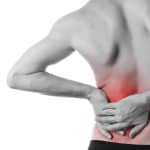Not all back pain is the same. Experienced massage therapists know that. However, it is often difficult to know the exact origins or causes of the pain. The muscles of the human body act together as a kind of machine, full of levers and pulleys, each one dependent on another to move arms and legs, to allow the trunk to twist and bend and for the head to pivot and nod.
Aches and pain in the lower back are often looked at along the spine and around the waist, but occasionally the pain can actually arise from a somewhat hidden source – the gluteus medius. The client may complain of lower back pain (LBP) and the massage therapist may focus his or her work in the lumbar area, when in actuality the pain is either being referred from the gluteus medius, or cause by a weakness in that muscle.
Where Is The Gluteus Medius and What Does It Do?
The muscles around the hip area and buttocks are very busy throughout a normal day. They engage when a person sits, stands, walks or does just about anything that involves moving the upper legs, or twisting the hips. The gluteus muscles are often joked about, but are important in helping to keep the human body from falling down.
The gluteus medius is located in between the gluteus minimus and gluteus maximus, sort of like the filling of a sandwich in between two slices of bread. One attachment lies along the external surface of the ilium, just below the iliac crest, and another on the lateral surface of the greater trochanter of the femur. Its actions include hip abduction, medial rotation and a bit of flexion in the hip joint as well as lateral rotation and extension. It helps to tilt the pelvis both anteriorly and posteriorly and to a lesser extent assists in the lateral tilt, depression of the pelvis, as well as contralateral and ipsilateral rotation.
For lower back and hip pain, the G. maximus is often looked to first, after ruling out muscles that attach along the spine itself. G. medius, perhaps because of its almost invisible anatomy, is hardly ever considered to be the culprit and often ignored completely. Yet, all three of the gluteal muscles work together and should not be ignored when it comes to a client’s complaint of pain.
Because of its attachment to the greater trochanter, a dysfunctional or injured G. medius might be to blame for pain somewhere on the leg. Tightness in this muscle can also be responsible for what is referred to as a functional short lower extremity. Less often, the G. medius has been shown be a contributing factor in low back pain.
Assessing the Origin of Low Back Pain
A very common complaint among clients seeking relief through massage therapy is chronic LBP. The area of pain can vary greatly and clients may describe pain as being along the ilium, along the lumbar spine or even as high as around the kidney area. The pain might be dull, burning, stabbing or just chronically achy. It is only through careful intake and thorough palpation of the area that a determination can be made as to the possible sources of discomfort.
Any number of muscular related pathologies can cause LBP, including stressed ligaments or fibrous connective tissue (aka fascia) in the area connecting the bones of the lower spine and the pelvis. Because the G. medius has an intimate connection to surrounding musculature and other adjacent structures, an injury to one may look like an injury to another, with the G. medius often overlooked. Pain can develop in the G. medius, or the surrounding area and may refer to lumbar muscles as well.
One way to find out where the pain originates is to see if the client can stand up straight or bend over without having pain. Injury to the gluteus muscles may cause this movement to respond to the muscle tightening and resulting nerve compression with pain. Referred pain patterns from a tight G. medius will usually form an arc along the top of the hip bone (iliac crest area), down into the buttock and across the sacrum.
Assessing the G. Medius
Studies have shown that standing without moving around is one of the primary causes of this type of LBP. This type of constrained posture is typical of cashiers in busy stores who must stand in one place ringing up merchandise for long periods of time. Using information provided by the client as to what kind of work they do or how they spend most of their day is helpful in determining the possible cause of their complaint when it comes to LBP.
Assessing during intake is perhaps the most crucial way of developing and understanding the origin of LBP. Have the client walk back and forth a few times. With a weak, painful or perhaps even ruptured G. medius he or she may tilt toward the weak side to reestablish a new center of gravity. This gait is referred to as the “gluteus medius lurch.”
The client can also be assessed while standing. If the G. medius is tight or shortened, there may be a lateral pelvic tilt, with the tight side being lower. This might appear on the surface to be similar to a slightly shortened leg, but palpation should be able to determine the difference.
Are Trigger Points the Problem?
Myofascial trigger points can also affect LBP. There are three associated with the G. medius which refer pain to the lower back. One is just below the iliac crest, lateral and superior to the posterior superior iliac spine (PSIS); another is about halfway between both the anterior and posterior superior iliac spine (ASIS, PSIS); the third is more rare and is just behind the ASIS, below the iliac crest. Pain can refer from these locations anywhere from the sacrum up through the lumbar region of the back.
How Can Massage Therapy Help?
One of the areas some massage therapists are timid about approaching is the area around the buttocks and hips. This may come in part because of concerns about maintaining a strict adherence to certain draping techniques. This shouldn’t, however, create a conflict with administering proper techniques which will help to reduce pain and increase mobility in a client with lower back pain. The draping can stop at the coccyx and still maintain a secure feeling. If in doubt, ask the client what he or she feels most comfortable with.
The hips contain very large and strong muscles. These muscles require massage techniques that can reach through many layers of tissue. Using the forearm for broad strokes, the elbow for depth and the hands to petrissage the muscles can be the most effective in reducing the stress and strengthening any weakness and, ultimately, reducing lower back pain.
Recommended Study:
Advanced Anatomy and Physiology
Advanced Anatomy for Professionals
Myofascial Release
Neuromuscular Therapy & Advanced Deep Tissue
Swedish Massage for Professionals
More Information:
Lower Back Pain: Massage Benefits and Precautions















